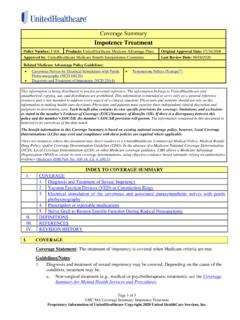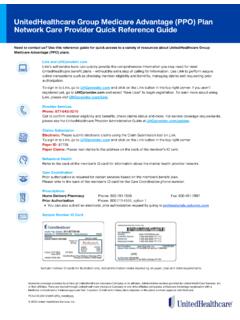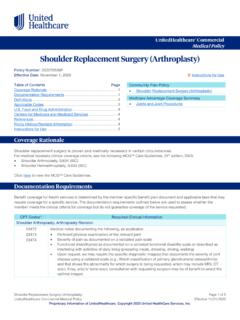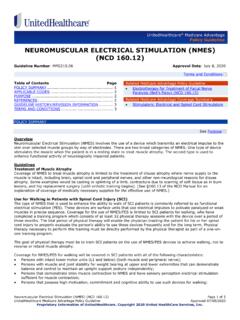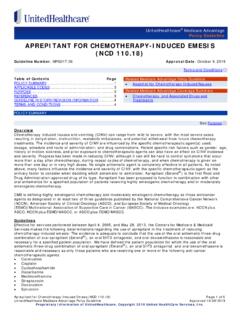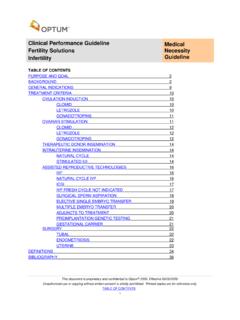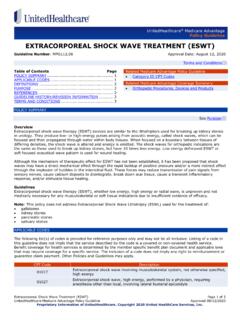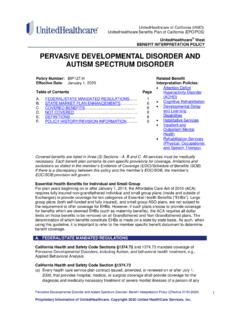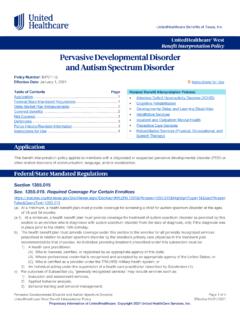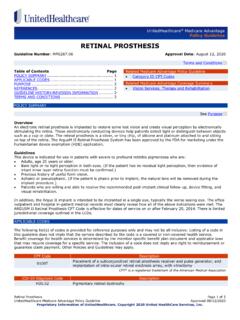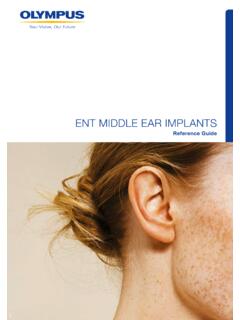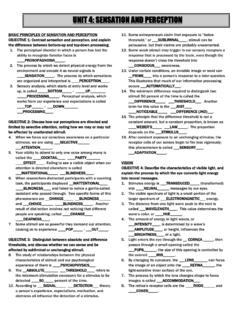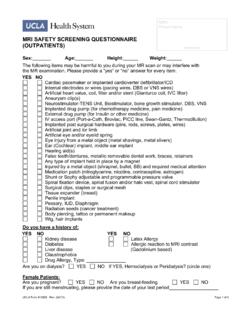Transcription of Hearing Aids and Devices Including Wearable, Bone …
1 Hearing Aids and Devices Including wearable , bone -Anchored and Semi-Implantable Page 1 of 21 UnitedHealthcare Commercial Medical Policy Effective 01/01/2022 Proprietary Information of UnitedHealthcare. Copyright 2022 United HealthCare Services, Inc. UnitedHealthcare Commercial Medica l Policy Hearing Aids and Devices Including wearable , bone -Anchored and Semi-Implantable Policy Number: 2022T0396Y Effective Date: January 1, 2022 Instructions for Use Table of Contents Page Coverage Rationale .. 1 Documentation Requirements .. 2 Definitions .. 2 Applicable Codes .. 3 Description of Services .. 5 Benefit Considerations .. 7 Clinical Evidence .. 8 Food and Drug Administration .. 13 References .. 19 Policy History/Revision Information.
2 20 Instructions for Use .. 20 Coverage Rationale See Benefit Considerations wearable air-conduction Hearing Aids required for the correction of a Hearing Impairment are proven and medically necessary. When used according to Food and Drug Administration (FDA) labeled indications, contraindications, warnings and precautions, the following are proven and medically necessary for Hearing loss in an individual who is not a candidate for an air-conduction Hearing Aid: Bilateral fully or partially implantable bone -anchored Hearing Aids for Conductive or Mixed Hearing Loss in both ears Bilateral or unilateral bone -anchored Hearing Aids utilizing a headband (without osseointegration) Semi-implantable electromagnetic Hearing Aid for Sensorineural Hearing Loss Unilateral fully or partially implantable bone -anchored Hearing Aids for Conductive or Mixed Hearing Loss in one or both ears Unilateral fully or partially implantable bone -anchored Hearing Aids for Sensorineural Hearing Loss in one ear The following are unproven and not medically necessary for treating Hearing loss due to insufficient evidence of efficacy.
3 Intraoral bone conduction Hearing Aids Laser or light-based Hearing Aids Totally implanted middle ear Hearing systems Related Commercial Policies Cochlear Implants Durable Medical Equipment, Orthotics, Medical Supplies and Repairs/Replacements Community Plan Policy Hearing Aids and Devices Including wearable , bone -Anchored and Semi-Implantable Medicare Advantage Coverage Summary Hearing Aids, Auditory Implants and Related Procedures Hearing Aids and Devices Including wearable , bone -Anchored and Semi-Implantable Page 2 of 21 UnitedHealthcare Commercial Medical Policy Effective 01/01/2022 Proprietary Information of UnitedHealthcare. Copyright 2022 United HealthCare Services, Inc. Documentation Requirements Benefit coverage for health services is determined by the member specific benefit plan document and applicable laws that may require coverage for a specific service.
4 The documentation requirements outlined below are used to assess whether the member meets the clinical criteria for coverage but do not guarantee coverage of the service requested. CPT/HCPCS Codes* Required Clinical Information Hearing Aids and Devices Including wearable , bone -Anchored and Semi-Implantable 69710, 69714, 69717, 69799, L8690, L8691, L8692 Medical notes documenting all of the following: What is being requested ( , bone anchored, semi-implantable, implantable, etc.) The type of Hearing loss (sensorineural vs. conductive or mixed) Severity and frequencies affected Whether or not member is a candidate for an air-conduction Hearing aid For replacement of any components, indicate date of initial purchase and the reason for replacement *For code descriptions, see the Applicable Codes section.
5 Definitions Conductive Hearing Loss: Occurs when sound is not conducted efficiently through the outer ear canal to the eardrum and the tiny bones (ossicles) of the middle ear. Conductive Hearing Loss usually involves a reduction in sound level or the ability to hear faint sounds. This type of Hearing loss can often be corrected medically or surgically. Degree of Hearing Loss: Degree of Hearing Loss Range (dbHL = decibels Hearing level) Normal Hearing -10 to15 dBHL Slight Loss 16 to 25 dBHL Mild Loss 26 to 40 dBHL Moderate Loss 41 to 55 dBHL Moderately Severe Loss 56 to 70 dBHL Severe Loss 71 to 90 dBHL Profound Loss 91 dBHL or more (ASHA , Type, Degree and Configuration of Hearing Loss; Clark, 1981) Frequency Modulated Systems (Auditory Trainers): A wireless connection to the listener s amplification system.
6 Hearing Aids: Hearing Aids are sound-amplifying Devices designed to aid people who have a Hearing Impairment. Most Hearing Aids share several similar electronic components, and technology used for amplification may be analog or digital. (Semi-implantable electromagnetic Hearing Aids and bone -anchored Hearing Aids are classified by the Food and Drug Administration (FDA) as Hearing Aids. Some non- wearable Hearing Devices are described as Hearing Devices or Hearing systems. Because their function is to bring sound more effectively into the ear of a person with Hearing loss, for the purposes of this policy, they are Hearing Aids). Hearing Impairment: A reduction in the ability to perceive sound which may range from slight to complete deafness.
7 Mixed Hearing Loss: Occurs when a Conductive Hearing Loss occurs in combination with a Sensorineural Hearing Loss (SNHL). In other words, there may be damage in the outer or middle ear and in the inner ear (cochlea) or auditory nerve. Hearing Aids and Devices Including wearable , bone -Anchored and Semi-Implantable Page 3 of 21 UnitedHealthcare Commercial Medical Policy Effective 01/01/2022 Proprietary Information of UnitedHealthcare. Copyright 2022 United HealthCare Services, Inc. Sensorineural Hearing Loss (SNHL): Occurs when there is damage to the inner ear (cochlea), or to the nerve pathways from the inner ear to the brain. Most of the time, SNHL cannot be medically or surgically corrected. This is the most common type of permanent Hearing loss.
8 Applicable Codes The following list(s) of procedure and/or diagnosis codes is provided for reference purposes only and may not be all inclusive. Listing of a code in this policy does not imply that the service described by the code is a covered or non-covered health service. Benefit coverage for health services is determined by the member specific benefit plan document and applicable laws that may require coverage for a specific service. The inclusion of a code does not imply any right to reimbursement or guarantee claim payment. Other Policies and Guidelines may apply. CPT Code Description Fitting and Testing of Hearing Aids 92590 Hearing aid examination and selection; monaural 92591 Hearing aid examination and selection; binaural 92592 Hearing aid check; monaural 92593 Hearing aid check; binaural 92594 Electroacoustic evaluation for Hearing aid; monaural 92595 Electroacoustic evaluation for Hearing aid.
9 Binaural Semi-Implantable Electromagnetic Hearing Aids (SEHA) 69799 Unlisted procedure, middle ear bone Anchored Hearing Aids (BAHA) 69710 Implantation or replacement of electromagnetic bone conduction Hearing device in temporal bone 69711 Removal or repair of electromagnetic bone conduction Hearing device in temporal bone 69714 Implantation, osseointegrated implant, skull; with percutaneous attachment to external speech processor 69716 Implantation, osseointegrated implant, skull; with magnetic transcutaneous attachment to external speech processor 69717 Revision or replacement ( Including removal of existing device), osseointegrated implant, skull; with percutaneous attachment to external speech processor 69719 Revision or replacement ( Including removal of existing device), osseointegrated implant, skull; with magnetic transcutaneous attachment to external speech processor 69726 Removal, osseointegrated implant, skull; with percutaneous attachment to external speech processor 69727 Removal, osseointegrated implant, skull.
10 With magnetic transcutaneous attachment to external speech processor CPT is a registered trademark of the American Medical Association HCPCS Code Description Fitting and Testing of Hearing Aids S0618 Audiometry for Hearing aid evaluation to determine the level and degree of Hearing loss V5010 Assessment for Hearing aid V5011 Fitting/orientation/checking of Hearing aid Fitting and Testing of Hearing Aids V5014 Repair/modification of a Hearing aid V5020 Conformity Evaluation V5264 Ear mold/insert, not disposable, any type Hearing Aids and Devices Including wearable , bone -Anchored and Semi-Implantable Page 4 of 21 UnitedHealthcare Commercial Medical Policy Effective 01/01/2022 Proprietary Information of UnitedHealthcare.
